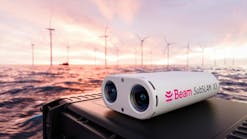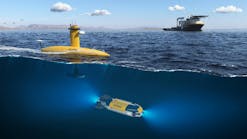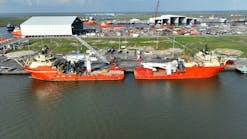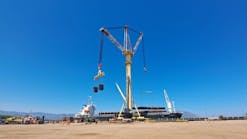Knock An, world's largest shuttle tanker, was recently delivered to Fend Olsen Tankers.
Upper Jurassic triumph for Saga
Saga has struck a potentially oil-rich vein southeast of the Tordis Field. The deviated well 34/7-25S, drilled in block 34/7 in 189 meters of water, flowed 6,600b/d and 3.7 million cf/d through a 15.9mm choke. At least 30 million bbl is thought recoverable: the Upper Jurassic sandstone reservoir is believed to show connection to the main Tordis reservoir. Like Tordis East, it could be brought onstream via a tieback to the Tordis template (Tordis itself is a subsea development from the Gullfaks Field). Saga has also upgraded the inventory for the Snorre Field to 1,315 million bbl, compared with the original estimate in 1988 of 767 million bbl. Improved understanding of the reservoir and more advanced production methods take the credit. Statoil too is revising expectations for Statfjord North, following two recent exploration wells. Well 33/9-19S, targeting a Brent structure on the eastern edge of block 33/9, is thought to have uncovered 50 million bbl of oil within the Jurassic: TD was 3,037 meters. The more recent 33/9-E-4H, drilled as a combined exploration/production well, has been testing the Y prospect south of Statfjord North. Chances of finding up to 100 million bbl were put at 25%. Any new crude, however, would have to wait its turn to pass through the crowded Statfjord North export pipeline. Statoil maintained its good run with a positive appraisal well on Tyrihans North in the Norwegian Sea which flowed 1,5750 b/d through a 12.7mm choke in 325 meters of water. Combined reserves from Tyrihans North and South are currently estimated at 95-125 million bbl and 26 bcm of gas: a standalone floater and a subsea tieback to the nearby Aasgard gas production semi are under consideration for the PDO, pending next spring. Also moving closer to an action plan is Norsk Hydro's Hermod in block 25/11, following a very productive extended well test which flowed up to 18,600b/d of oil with moderate water production. The 365 million bbl appear a good candidate for an FPSO.Gas impasse under review
Talks are set to resume over Norwegian gas exports to the UK via the Frigg pipeline system. Deliveries have dwindled to 1.7 bcm/yr, just 2% of UK demand, from a high of 14 bcm in 1985 as the Frigg reservoir depleted. The UK government has refused to admit replacement supplies through the system from newer Norwegian fields such as Froy because of over-capacity in Britain's own gasfield/infrastructure network. However, with the likely emergence by next winter of a genuine spot market for gas, there might be room for flexible suppliers to meet UK cold weather demand, even from Norway, according to British Gas's E&P managing director Dr Pierre Jungels. The latest batch of landward-bound gas comes from Shell's Schooner Field in the southern North Sea, which last month started feeding 130 mcf/d to Theddlethorpe via the Caister Murdoch pipeline system. In the same region, Conoco's block 44/21a, two-structure Boulton Field has gained DTI development approval for a projected production start of spring 1998. One normally unmanned platform will serve two producer wells (one of these possibly a dual-lateral), feeding Boulton gas to the Murdoch platform through a newly installed riser and onward to Theddlethorpe.Around 165 bcf of wet gas should be recovered over 17 years. New compression facilities were recently added to the Caister-Murdoch system to handle gas from Boulton and other Carboniferous discoveries at up to 750 mcf/d.
Gas production spreads north
Off Norway, the much grander Troll Field has finally begun issuing gas, at the rate of 40 million cm/d to the Kollsnes treatment plant near Bergen, following a four-month test period. One of the field partners, Saga, has also applied to the Norwegian Gas Supply Committee to allocate volumes from its PL 199 production licence area for the next round of Norwegian export sales contracts. The gas would come from the B structure in block 6406/2, thought to contain 80 bcf. This could be developed standalone or as a tieback to the Aasgard platform; the final choice should be established next June. Another gas-gathering complex could be emerging in the Barents Sea. Statoil has revived its efforts to find an economic development solution for the Snohvit, Askeladden and Albatross fields which hold combined reserves of over 7 tcf. Due to the remoteness of the location, LNG conversion seems the only economic option. For the development, Statoil appears to favor a fully subsea solution on the lines of TOGI, involving perhaps two six-slot templates connected to a subsea manifold. The wellstream would be piped around 140 km to the new onshore LNG processing plant via a multiphase line (Snohvit also contains 90 million bbl of oil and NGLs). UK analysts Wood Mackenzie price this scenario, producing 5 bcm/yr, at Nkr15-16 billion, but that would not cover the costs of getting the LNG to world markets. An even more expensive alternative would be to use a floating production system, but at least this would allow tie-in of other fields over a phased period. Assuming buyers for the LNG can be found, development could kick off in 1998, leading to production by 2002.West Brae/Sedgwick combo rejected
After 18 months of negotiation, Marathon and partners have decided to go it alone with the West Brae oilfield rather than attempt a joint development with the Sedgwick Field. West Brae, in UK Central North Sea block 16/7a, will be tied back subsea to Marathon's Brae A platform, 8.7 km away, with three horizontal producer wells and one water injector to maintain field pressure. The subsea manifold will have spare slots to accommodate tie-ins of other Marathon-operated or third party prospects. McDermott will handle engineering plus installation of the umbilical and flowlines. A bundled riser will be installed on a spare conductor slot on the Brae A platform, rather than retrofitting a riser externally. First oil from this 30 million bbl field could be ready late next year, climbing to 25,000 b/d in 1998. Associated gas could be sent to the platform for fuel. Enterprise, the operator of Sedgwick, is now leaning towards an FPSO for this 30 million bbl prospect, following two further appraisal wells in the first half of 1997. Oryx is proceeding with development of Columba, one of three downthrown fault blocks west of the Ninian Field estimated to contain 40 million bbl of oil combined. Columba B's 10 million bbl will be accessed initially from a single well drilled from the Ninian South platform, and could be onstream before the end of this year. In other UK oil developments, Ranger Oil confirms that the extended well test on the Pierce Field fulfilled its targets, improving understanding of productivity and the recovery mechanisms. BP as field operator will likely proceed to the development stage in 1997.Mobil has brought the 50 million bbl Nevis Field on line as a tieback to the Beryl A platform: maintenance of the subsea wells will be wholly diverless. And Amoco is reviewing a subsea tieback of its 10 million bbl-plus Halley discovery in block 30/12b following a successful appraisal well - possibly to Shell's Fulmar or the Clyde Field platform.
Copyright 1997 Oil & Gas Journal. All Rights Reserved.





